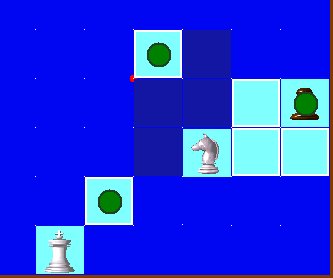Tiled Squares Chess
By Tony Quintanilla
Introduction
"Tiled Squares Chess" has evolved from my "Chameleon Chess" and "Shifting Sands Chess", particularly the idea that the properties of the squares affect the powers of the pieces. Ralph Betza's "Shifted Square Chess" and "More Shifted Square Chess" and Gavin King's "Motorotor" also suggested that the board is not immutable.
Setup
The initial setup is identical to FIDE Chess, except that the 3rd through 6th ranks of the board have no tiles--that is, the board is a void between the piece arrays!
Pieces
The standard FIDE pieces are used.
Rules
All the normal rules of Chess apply with the following exceptions:
- During a turn players may either move piece, drop a Tile on the board, remove a Tile, or drop an Anti-Tile on the board.
- Tile and Anti-Tile drops must follow the board's normal rank and file lines. They may be dropped on any empty space on the board.
The image below illustrates how to drop a Tile.
The image below illustrates how to drop an Anti-Tile.
- All pieces may make their normal FIDE moves except that they may only land on a Tile. The only exception is the King, which may move to any space that does not have a friendly piece on it, and which is not threatened by an opposing piece or will not be threatened by an opposing piece immediately upon being created by the King. The King creates a Tile on an untiled space as it lands on it, or replaces an Anti-Tile with a Tile as it lands on it.
That is, pieces cannot land on a non-existent part of the board that has not yet been created. As they make these moves, they may move over non-existent parts of the board, just not land there. Remember that all pieces are on Tiles, so capture is never affected by this rule.
The image below illustrates the Queen's movement capabilities. This image shows the Tiles dropped by White outlined in white and those dropped by Black outlined in black. However, for the purposes of movement, it does not matter which player dropped the Tile.
The only piece that ignores this rule is the King. Note that the King may not create and move onto a Tile on a space where it will be threatened by an opposing piece, even though that space is not currently threatened because it has no Tile. The King's movement capabilities are illustrated below.
- Pieces may not pass through Anti-Tiles, the only exception is the Knight. Pieces may not land on an Anti-Tile, the only exception is the King.
The Knight may not land on an Anti-Tile, but may leap over Anti-Tiles. The King ignores the Anti-Tile altogether. As shown above, the King moves wherever he wishes and creates a Tile as he goes and leaves a Tile upon exiting a space. The Knight's movement capabilities are illustrated below.
- A Tile may be removed from the board under the following conditions: it was dropped by the player removing it and has not since been occupied by an opposing piece; the Tile was last occupied by a friendly piece; or it was created as a result of a move by the friendly King.
In other words, in some respects a player can be said of own certain Tiles. This ownership, however, has no affect on movement, only on the ability to subsequently remove that Tile from the board. Ownership in the above illustrations is designated by a white or black border.
- Anti-Tiles may not be removed from the board except when a King moves onto an Anti-Tile. Note that it does not matter in any way which player drops an Anti-Tile. Hence, there is no need to differentiate Anti-Tiles by player.
Playing Tips
Tiled Squares Chess is most different during the opening and early middle game. As the board become more filled in it becomes progressively more like FIDE Chess, although removing Tiles and dropping Anti-Tiles can change this trend.
The initial moves in the game should be focused on dropping Tiles where your initial moves will be made. Of course, your opponent can also make use of your Tiles.
Adding an Anti-Tile is a powerful option to block certain ranks, files and diagonals, however, bear in mind that once dropped Anti-Tiles cannot be removed except by the King moving to an Anti-Tile.
Notes
Again, the idea of creating the board as one goes can be applied to almost any Chess variant, with various board sizes, board configurations, rules and piece arrays
Computer Play
If you have Zillions of Games installed on your computer, you can play this game. Download the ZRF as the below link.The images on this page were created using this ZRF.
Equipment
Standard Chess equipment can be used. Some kind of designation to indicate squares that have Tiles, no Tiles, or anti-Tiles is needed.





